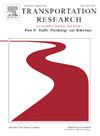Drive first or yield? Effect of complexity on cooperation behavior at deadlock-situations at T-intersections
IF 3.5
2区 工程技术
Q1 PSYCHOLOGY, APPLIED
Transportation Research Part F-Traffic Psychology and Behaviour
Pub Date : 2025-02-01
DOI:10.1016/j.trf.2024.12.035
引用次数: 0
Abstract
Deadlock-situations at intersections, where the right-of-way is not clearly regulated, pose challenges for automated vehicles (AVs) in mixed traffic. For AVs to show behavior that is accepted by all traffic participants, it is important to understand the cooperation behavior of manual drivers in these situations. Three studies were conducted where the effect of complexity on cooperation behavior at deadlock-situations was examined. Participants watched videos of approaches to T-intersections where a deadlock-situation occurred but was not yet resolved. After each video they reported their intended behavior, the perceived difficulty and visual clutter of the situation as well as the anticipated behavior of the cooperation vehicles. Complexity was manipulated with visual built clutter, pedestrians and additional traffic. Results show minimal effect of complexity on perceived difficulty and visual clutter as well as cooperation behavior. However, cooperation behavior was significantly influenced by approach position. When approaching from below drivers are more likely to yield compared to approaches from left or right. Additionally, when a vehicle is driving through the intersection directly in front of the driver they show higher probabilities of driving first through the intersection. The anticipated behavior of the cooperation vehicles is influenced both by their approach position and the right-of-way rule from the driver’s perspective, suggesting that the right-of-way rules are not correctly understood and therefore the deadlock-situation is not recognized as such. Recommendations for the behavior of automated vehicles in these situations are derived from the findings of the studies.
求助全文
约1分钟内获得全文
求助全文
来源期刊
CiteScore
7.60
自引率
14.60%
发文量
239
审稿时长
71 days
期刊介绍:
Transportation Research Part F: Traffic Psychology and Behaviour focuses on the behavioural and psychological aspects of traffic and transport. The aim of the journal is to enhance theory development, improve the quality of empirical studies and to stimulate the application of research findings in practice. TRF provides a focus and a means of communication for the considerable amount of research activities that are now being carried out in this field. The journal provides a forum for transportation researchers, psychologists, ergonomists, engineers and policy-makers with an interest in traffic and transport psychology.

 求助内容:
求助内容: 应助结果提醒方式:
应助结果提醒方式:


